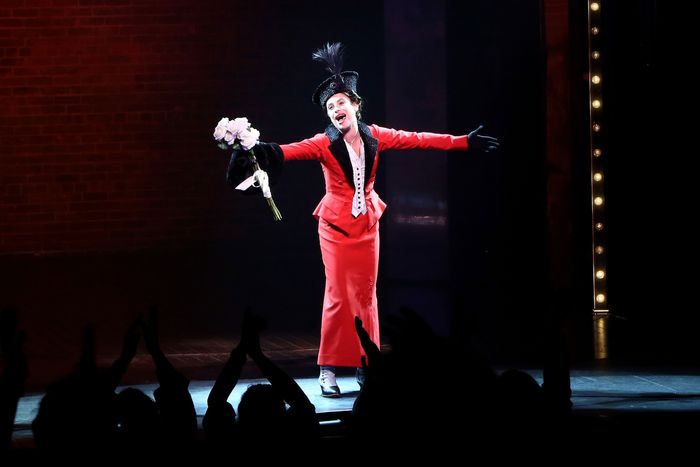
Seconds before the lights went down at Lea Michele’s first performance of Funny Girl, Jonathan Groff sped down the aisle to his seat at the center of the orchestra, right next to Ryan Murphy, who gave the actress a starring role in Glee. “I knew he’d be here,” the woman sitting next to me muttered under her breath. “There he is. Slay!” As soon as Michele appeared onstage, Groff, her close friend since the days of the 2006 musical Spring Awakening, popped up to lead a standing ovation. After a decades-long, controversy-filled history of desperately wanting to play Fanny Brice, Lea Michele was finally in the role on Broadway. At the first performance, the audience was there to cheer on the greatest star, though you could put any part of that fervent sentiment in air quotes.
The stakes of Michele’s entrance into the show are clear: Funny Girl, the first Broadway revival of the show since Streisand opened it in 1964, premiered this spring, inauspiciously on Barbra’s 80th birthday, starring Beanie Feldstein as Fanny Brice. Feldstein could not sing the part (and the reviews weren’t kind to the rest of the production, either). After getting blanked at the Tonys, the show started to flounder in ticket sales, and rumors bubbled that Feldstein might soon be replaced. By the time it leaked that Michele was going in for Fanny, Feldstein announced plans to leave early on her own accord, implying she was unhappy the show was going in a “different direction.” Michele has been basically auditioning to play Fanny Brice since she first appeared on Glee, where she kept delivering performances in that Barbra vein, but there are plenty of good reasons to be suspicious of her casting. She’s also accused of bullying her co-stars and racist behavior. (She swears, in her most recent Times profile, she has cleaned up her act.)
There were only a few glimpses of argyle in the crowd, a nod to Michele’s role as Rachel Berry on Glee. Instead, the audience seemed full to the brim with characters from the great blob of the theater world: agents, producers, co-producers, seemingly entire staffs of Broadway ad agencies, reporters, and the theater owner Jordan Roth. There was also a mix of celebrities from a category I think of as “Thom Browne–ad-campaign adjacent,” including Lee Pace and his husband, Thom Browne himself, Drew Barrymore, Zachary Quinto, Spring Awakening’s John Gallagher Jr. and Gideon Glick, and, of course, Murphy and Groff. Also there for some reason: Kathy Hochul. Less a natural crowd for Michele to make her entrance than Astroturf.
The ethos of the evening is best described by that one screenshot of Kurt Hummel in Glee responding to Miss Rachel Berry with “she may be difficult, but boy can she sing.” I will leave it to the critics who show up in a few weeks once things have settled to parse how well the whole thing works when people who aren’t personally, financially, or ironically invested in the success of the experience are in the audience. But Michele sang like her career depended on it. Her voice can soar. By my count from an orchestra seat, there were four standing ovations in the first act: for her entrance, “The Greatest Star,” “People,” and “Don’t Rain on My Parade.” (The first began with Groff and, in the mezzanine, with someone Twitter has already dubbed “a twink in opera gloves.”) In the second act, there were two more, her entrance and the closing reprise, which were sustained through the curtain call. (Does that make it seven? Nobody told me the rules.) Shout out to the smattering of audience members who tried to get people up for Ramin Karimloo’s “Temporary Arrangement” and for Jared Grimes and newcomer Tovah Feldshuh’s “Who Taught Her Everything She Knows?” And, if you want a case study in Michele doing comedy, there she was tap dancing and fiddling with a prop mustache that simply would not stick during “Rat-Tat-Tat-Tat.”
The awareness of Michele’s more spotty reputation as a star came in, almost involuntarily, in the several moments where Fanny Brice jokes about not being very well-read. There’s a longstanding bit of internet lore that Michele herself can’t read that’s grown in steam as her reputation for being cruel to her castmates has become better known. (She denied the illiteracy allegations to the Times, which has only made them more of a meme). So when Fanny tells Nick Arnstein that he acts like a character in a book, and “I haven’t read many books, so …” there were the obligatory face-value laughs at the lame joke and the rumbles of deeper recognition at the meta-joke — plus the stern hushings of people who also know the joke but do not find it funny. (A friend heard someone mutter, “Don’t do that!” near them.) By the time Fanny admitted she doesn’t know what patronizing means in Act Two, it felt like dissension might break out between those who were simply there to support and those who were also hoping to snicker. That’s what happens when the crowd seems to exist on separate, colliding tectonic plates, one-half wanting to see redemption and the other tilting a bit toward comeuppance.
The show ended just before 10 p.m., running under the wire of three hours (and no, for the record, they haven’t added in “My Man”). Michele and Feldshuh both received giant bouquets during their bows and looked suitably farklempt, cheered on by Groff and Murphy and the woman sitting next to me, who was now crying. Then the audience spilled out into the street in a burst of energy and takes. There were huddled conversations among friends. Fox 5 set up a video camera recording testimonials for local news. People pulled out hats and posters and gathered near the stage door waiting for Michele to emerge. Once she did, it was almost impossible to make her out through the crowd of people, all willing this big star-arriving moment into existence. Near the back, that same fan in opera gloves shouted, “Lea, I can’t see you, but you fucking ate!”





